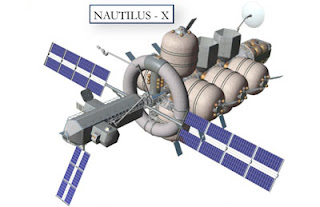The Asteroid Menace
Day one of the Exploration of Near Earth Objects Objectives Workshop saw the presentation of three key reasons to send humans to visit asteroids: science, mining and planetary protection. Of these, the last has has been shown to be an issue that attracts mainstream support, no doubt we have Bruce Willis to thank for this.
The workshop began with presentations of the robotic missions that have been flown to asteroids and comets. The recently returned sample return mission Hayabusa, taking pride of place. All the presenters had war stories of the operational difficulty of flying to these objects, and some expressed surprise that their missions succeeded at all. They also talked about the high cost of these missions in terms of remote sensing equipment and the lack of good ground truth information to calibrate these instruments.
Unsurprisingly then, they all support a human mission to an asteroid or a comet near Earth to more efficiently gain scientific results. However, when asked about planetary defense, the consensus opinion wasn't just that a human mission would be nice: it is absolutely necessary.
An asteroid is heading to Earth that will kill every one of us, someday. Hopefully we will discover it and track it for long enough to have 5 or 10 years prior notice. Now what? We'd love to send a robotic probe to get some idea of what the object looks like, what it is made of, how fast it is rotating, etc. Unfortunately, a robotic mission will take at least 5 years to go from concept to launch and it has a very low chance of success at even this precursor mission. Sending a robotic mission to deflect or otherwise mitigate the threat is simply unthinkable at this time.
That means we need to send humans, and it means we need to send them to meet the threat with no robotic precursor. The astronauts will do the scientific investigation to determine the composition of the object. This will most likely include planting seismic detectors, and launching one or more kinetic impactors into the surface. Relaying this data back to Earth, the astronauts would wait for ground control, probably with the support of the national laboratories, to decide on a mitigation plan. Obviously the plan will be limited by what the astronauts have with them, so they will need to carry an array of tools for the various types of threats that may be expected.
For example, the best strategy may be to install large motors which provide constant thrust for a period of years diverting the asteroid off course just enough to miss the Earth. Such a strategy would only be possible on objects where in-situ resource utilization could produce sufficient propellant. Another strategy may just be the placement of a station keeping spacecraft with a lot of mass, possibly removed from the surface of the object, to act as a "gravity tractor", again diverting the course away from Earth. More exotic strategies may include converting rotational energy into propulsive energy using long tethers or in the drastic use of nuclear bombs.
The workshop continues today and is being webcast. Ultimately, failure to send astronauts to visit near-Earth objects within the next few decades will be fatal to humanity, so tune in and participate.
The workshop began with presentations of the robotic missions that have been flown to asteroids and comets. The recently returned sample return mission Hayabusa, taking pride of place. All the presenters had war stories of the operational difficulty of flying to these objects, and some expressed surprise that their missions succeeded at all. They also talked about the high cost of these missions in terms of remote sensing equipment and the lack of good ground truth information to calibrate these instruments.
Unsurprisingly then, they all support a human mission to an asteroid or a comet near Earth to more efficiently gain scientific results. However, when asked about planetary defense, the consensus opinion wasn't just that a human mission would be nice: it is absolutely necessary.
An asteroid is heading to Earth that will kill every one of us, someday. Hopefully we will discover it and track it for long enough to have 5 or 10 years prior notice. Now what? We'd love to send a robotic probe to get some idea of what the object looks like, what it is made of, how fast it is rotating, etc. Unfortunately, a robotic mission will take at least 5 years to go from concept to launch and it has a very low chance of success at even this precursor mission. Sending a robotic mission to deflect or otherwise mitigate the threat is simply unthinkable at this time.
That means we need to send humans, and it means we need to send them to meet the threat with no robotic precursor. The astronauts will do the scientific investigation to determine the composition of the object. This will most likely include planting seismic detectors, and launching one or more kinetic impactors into the surface. Relaying this data back to Earth, the astronauts would wait for ground control, probably with the support of the national laboratories, to decide on a mitigation plan. Obviously the plan will be limited by what the astronauts have with them, so they will need to carry an array of tools for the various types of threats that may be expected.
For example, the best strategy may be to install large motors which provide constant thrust for a period of years diverting the asteroid off course just enough to miss the Earth. Such a strategy would only be possible on objects where in-situ resource utilization could produce sufficient propellant. Another strategy may just be the placement of a station keeping spacecraft with a lot of mass, possibly removed from the surface of the object, to act as a "gravity tractor", again diverting the course away from Earth. More exotic strategies may include converting rotational energy into propulsive energy using long tethers or in the drastic use of nuclear bombs.
The workshop continues today and is being webcast. Ultimately, failure to send astronauts to visit near-Earth objects within the next few decades will be fatal to humanity, so tune in and participate.



Thank you for this article. I read it with interest!
ReplyDeleteFinally they are doing this!
ReplyDeleteNow for me to start producing brochures for "Plan B"!
I will charge 1-5 million dollars for guaranteed placements in a self contained underground facility.
Once I've sold several placements, I can build it!
Interestingly, Trent.
ReplyDeleteImagine that there may be more difficult. A giant asteroid, brittle or soft, along with others like. Jesus! Other day I saw a suggestion to use long cables, which reduces the force required to move the asteroid en route. Interesting. The problem is to bring both cables to a place so far, and they burst. I believe the construction of ships "tractors" is the best alternative. The concept seems fictional, but now there is this possibility. Ships strong, without consumption of oxidizing, electric, able to move large tonnages. Finally, an alternative is the use of solar sails. I do not know what the power of these solar sails, but any push into space makes a huge difference. Any company financed by national governments or nations themselves, in unity, should mitigate these problems. Anyway, we'll have to pray a lot, those who believe in God.
The gravity tractor does not supplant the need for lots of propulsion, it just allows that propulsion to be applied without concern for a mechanical coupling to the asteroid. You still need a heroic amount of momentum change to deflect the object.
ReplyDeleteThe video of the conference on nuclear interaction with an asteroid from NewSpace Expo was fascinating.
ReplyDeleteThe biggest thing I came away with is that you aren't really "steering the asteroid away" from an impact, you're speeding it up so that it passes through the point of potential impact days before the Earth gets there. All force is applied prograde, and if done years before the potential impact, very little force (isp? delta-v?) is required to do the trick.
On the other hand, there is probably a good sized rock out there that we aren't tracking yet. So as far as I'm concerned, the sooner we do the first mission to get the technology working, the better.
Nice article. Your closing line was a bit over the top though: "Ultimately, failure to send astronauts to visit near-Earth objects within the next few decades will be fatal to humanity." It's not like we just recently settled on the planet and discovered that the neighborhood was very dangerous. As much as I personally want to see us settling the solar system soon, I have a hard time believing it's that urgent.
ReplyDeleteThis comment has been removed by a blog administrator.
ReplyDeleteTom, that's like saying you don't need to bother putting good locks on your doors because you've lived in a house where the previous occupants were all killed by intruders and you've only had small things stolen lately. As soon as we can do these missions we should.
ReplyDeleteG'day,
ReplyDeleteI have just blogged an essay on this very topic.
http://discoveryenterprise.blogspot.com/2010/08/need-for-planetary-defense.html
ta
Ralph
The recently released NRC study on NEO defense came to exactly the opposite conclusion. The consensus opinion was that a human mission was nice: but it is not absolutely necessary.
ReplyDeleteThe NRC reviewers have little vested interest. ESMD does. So be careful whose conclusion you choose to adopt.
...a possible solution... INCREASING ITS SPEED, gives it a shove, TOWARDS A SIDE IF THERE ARE LITTLE TIME, to what speed gives it thrust towards a side for deflecting it?...speed = space/time...so if want that it passing "close shaving" to 1,000 kms from Earth = 1 million mts, and having approx. 11 days = 1 million seconds, the correction speed will be of: 6,000 kms approx. Earth radius + 1,000 kms = 7,000 kms; 7 million mts/1 million seconds = 7 mts/second (25 kms/hour). If it increases forwards speed, it climbs to a higher orbit and vice versa: circular orbit radius = (mass*speed²)/force (centripetal) from Sun gravitational attraction. All orbits are more or less elliptical.
ReplyDelete